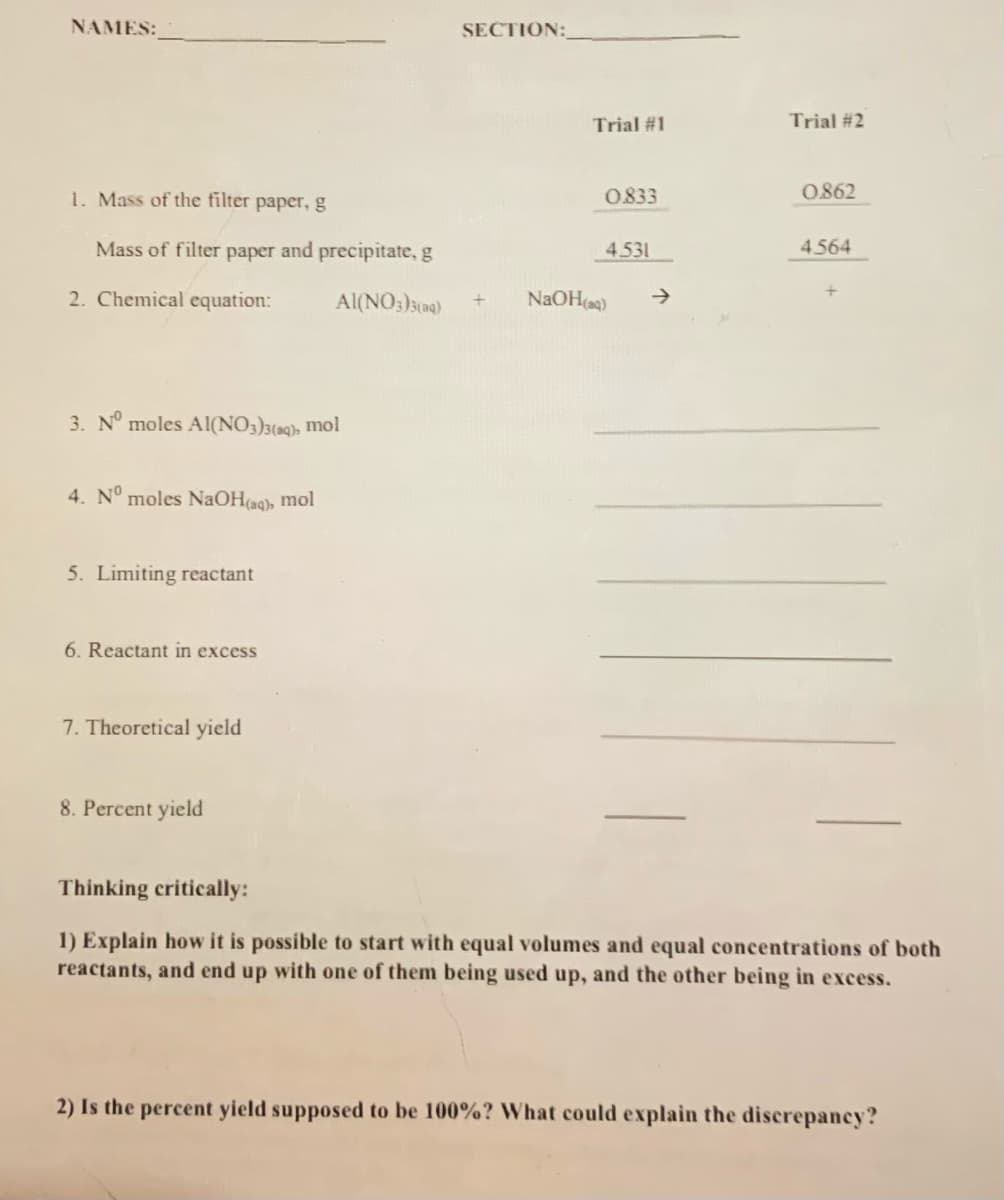NAMES: SECTION: Trial #1 Trial #2 1. Mass of the filter paper,g 0833 0862 Mass of filter paper and precipitate, g 4.531 4.564 2. Chemical equation: Al(NO;)3(ag) NaOH(a) -> 3. N° moles AI(NO3)3(aq), mol 4. N° moles NaOHag), mol 5. Limiting reactant 6. Reactant in excess 7. Theoretical yield 8. Percent yield Thinking critically: 1) Explain how it is possible to start with equal volumes and equal concentrations of both reactants, and end up with one of them being used up, and the other being in excess. 2) Is the percent yield supposed to be 100%? What could explain the discrepancy?
NAMES: SECTION: Trial #1 Trial #2 1. Mass of the filter paper,g 0833 0862 Mass of filter paper and precipitate, g 4.531 4.564 2. Chemical equation: Al(NO;)3(ag) NaOH(a) -> 3. N° moles AI(NO3)3(aq), mol 4. N° moles NaOHag), mol 5. Limiting reactant 6. Reactant in excess 7. Theoretical yield 8. Percent yield Thinking critically: 1) Explain how it is possible to start with equal volumes and equal concentrations of both reactants, and end up with one of them being used up, and the other being in excess. 2) Is the percent yield supposed to be 100%? What could explain the discrepancy?
Chemistry & Chemical Reactivity
10th Edition
ISBN:9781337399074
Author:John C. Kotz, Paul M. Treichel, John Townsend, David Treichel
Publisher:John C. Kotz, Paul M. Treichel, John Townsend, David Treichel
Chapter1: Basic Concepts Of Chemistry
Section: Chapter Questions
Problem 49RGQ: Fluoridation of city water supplies has been practiced in the United States for several decades. It...
Related questions
Question
100%
If all could be answered. Each question can be subtracted from how many questions I have left to ask.

Transcribed Image Text:NAMES:
SECTION:
Trial #1
Trial #2
1. Mass of the filter paper, g
0833
0862
Mass of filter paper and precipitate, g
4.531
4.564
2. Chemical equation:
Al(NO:)s(a)
NAOH(a)
->
3. N° moles Al(NO3)3(aq), mol
4. N° moles NAOH(aq), mol
5. Limiting reactant
6. Reactant in excess
7. Theoretical yield
8. Percent yield
Thinking critically:
1) Explain how it is possible to start with equal volumes and equal concentrations of both
reactants, and end up with one of them being used up, and the other being in excess.
2) Is the percent yield supposed to be 100%? What could explain the discrepancy?
Expert Solution
This question has been solved!
Explore an expertly crafted, step-by-step solution for a thorough understanding of key concepts.
This is a popular solution!
Trending now
This is a popular solution!
Step by step
Solved in 3 steps

Knowledge Booster
Learn more about
Need a deep-dive on the concept behind this application? Look no further. Learn more about this topic, chemistry and related others by exploring similar questions and additional content below.Recommended textbooks for you

Chemistry & Chemical Reactivity
Chemistry
ISBN:
9781337399074
Author:
John C. Kotz, Paul M. Treichel, John Townsend, David Treichel
Publisher:
Cengage Learning


Principles of Modern Chemistry
Chemistry
ISBN:
9781305079113
Author:
David W. Oxtoby, H. Pat Gillis, Laurie J. Butler
Publisher:
Cengage Learning

Chemistry & Chemical Reactivity
Chemistry
ISBN:
9781337399074
Author:
John C. Kotz, Paul M. Treichel, John Townsend, David Treichel
Publisher:
Cengage Learning


Principles of Modern Chemistry
Chemistry
ISBN:
9781305079113
Author:
David W. Oxtoby, H. Pat Gillis, Laurie J. Butler
Publisher:
Cengage Learning

Chemistry: An Atoms First Approach
Chemistry
ISBN:
9781305079243
Author:
Steven S. Zumdahl, Susan A. Zumdahl
Publisher:
Cengage Learning


Chemistry for Engineering Students
Chemistry
ISBN:
9781337398909
Author:
Lawrence S. Brown, Tom Holme
Publisher:
Cengage Learning